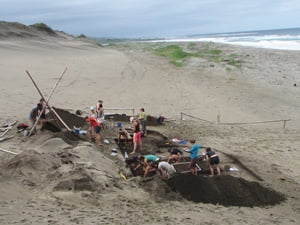Sigatoka Sand Dunes at the mouth of the Sigatoka River on the Coral Coast, is home to a complex of archaeological sites of the Navatu phase (AD 200-1000) which provide evidence for solar salt production practiced as a household-based skill.
The Navatu phase refers to post-Lapita occupations in Fiji, dated between 2100-900 years ago (BP), with cultural characteristics thought to have been influenced by contact with Vanuatu and New Caledonia.

This was the first report of prehistoric salt-working in the Pacific, one that used solar evaporation of sea water on large flanged clay dishes. This short-lived industry of the seventh century AD disappeared beneath the dunes, but its documented nineteenth- and twentieth-century successors offer it many useful analogies: the salt, now extracted by boiling brine, was supplied to inland communities upriver, where it functioned as a prime commodity for prestige and trade and an agent of social change.
Archaeological surveys and excavations in the late 1960s, identified significant evidence of salt working, but it wasn’t until the early 21st century that archaeologists identified a definite salt production site in Nadroga.
Among the archaeological finds was a small village, occupied between 610-675 AD. An expedition in 2000-2002, the village was found to have a range of house foundations and storage pits, artifacts and faunal materials. Nearly 11,000 pottery sherds were recovered at the site, but only three could be associated with salt production: clearly, salt production took place someplace further away from the village.
Salt Processing aorund Sigatoka
In 2006, archaeologists identified and began excavating a salt processing station, situated on a flat part of the beach about one kilometer (1/2 mile) from the village.
Recent studies of salt production in the present day in nearby modern villages gave scholars evidence to work from, to identify salt production techniques. To create salt for trade, modern Fijians excavate a collection pond and collect saltwater from it at low tide. The brine is poured into large flat heavy pans set over an open fire in a wooden structure. The salt is evaporated out of the water after a full day’s boiling, and then packed into a container, where the salt is formed into a block. Finally, the salt blocks are decorated for sale.
Salt production at Sigatoka Sand Dune was identified through the presence of a type of coarse-grained ceramic vessel called a salt tray. Also found at Sigatoka were over 2,000 sherds from globular, well-fired jars with in-turned (everted) rims, often decorated with nail impressions and incised patterns. Tthese were used to transport water or perhaps hold the brine to create cakes of salt.
A small hearth with coral cobbles, volcanic stone and large ceramic sherds was discovered near the ceramic scatter is thought to be an open air kiln which might have been used to fire the trays.
Clay suitable for potting does not occur at Sigatoka Sand Dunes, but it is believed to have been transported to the site from over a kilometer away.
A total of 900 liters of salt could be produced over a three month period, by a single household of salt producers, for trade with non-coastal people.
Archaeology at Sigatoka
Excavations at Sigatoka were completed during field schools between 2000 and 2006 led by David Burney of Simon Fraser University, and with support of the National Trust for Fiji, Fiji Museum, Fiji Ministry of Immigration and Mr Chris Work, Kulukulu village.
Sources
Burley DV, Tache K, Purser M, and Balenaivalu RJ. 2011. An archaeology of salt production in Fiji. Antiquity 85(327):187-200.
Clark G, and Anderson A. 2009. Fieldwork in northern Viti Levu and Mago Island. In: Clark G, and Anderson A, editors. The Early Prehistory of Fiji. Canberra: Australian National University. p 121-152.
Clark G. 2009. Post-Lapita ceramic change in Fiji. In: Clark G, and Anderson A, editors. The Early Prehistory of Fiji. Canberra: Australian National University. p 307-320.



You must be logged in to post a comment.